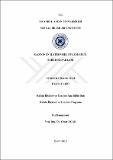Please use this identifier to cite or link to this item:
http://hdl.handle.net/11547/2124Full metadata record
| DC Field | Value | Language |
|---|---|---|
| dc.contributor.author | Çelebi, Hayri | - |
| dc.date.accessioned | 2019-05-25T05:37:02Z | - |
| dc.date.available | 2019-05-25T05:37:02Z | - |
| dc.date.issued | 2016 | - |
| dc.identifier.uri | http://hdl.handle.net/11547/2124 | - |
| dc.description.abstract | Kitle iletişim araçları yazılı basından başlayarak, elektronik kitle iletişim araçlarına oradan da günümüzde hızla gelişimini sürdüren sosyal medyaya kadar, farklı şekillerde var olan ama her zaman dördüncü kuvvet olduğu düşünülen konumunu korumaktadır. Elektronik kitle iletişim araçlarının ilklerinden olan ve 20. Yüzyılın ilk çeyreğinde insanlığın yaşamına katılan radyo, Birinci Dünya Savaşı’nın ardından yeniden şekillenen siyasal yapı içinde önemli bir görev üstlenmiştir. Bu dönemde radyonun siyasal ve iletişimsel eylem gücü olduğunun farkına varılmış, eğitimden, politikaya, sağlıktan, kültüre kadar devletler tarafından her alanda yapılan çalışma radyo aracılığıyla topluma yayılmaya çalışılmıştır. Yine, radyonun iletişimsel eylem gücünün etkisi ve katkısıyla, özellikle 20. yüzyılda son şeklini almaya başlayan ulus-devlet yapısı daha da güçlendirilmeye çalışılmıştır. Teknolojinin gelişmesiyle medyanın artık, televizyon, bilgisayar ve nihayet yeni medya gibi geniş bir yelpazede tanımlanmaya başlamasıyla, kimilerine göre radyo artık bir müzik kutusu haline gelmiş ve siyasal iletişim gücünü kaybetmiştir. Kimilerine göreyse radyo halen etkin bir kitle iletişim aracı olarak siyasal iletişimin bir parçası olarak önemli bir işlevini sürdürmeye devam etmektedir. Bu çalışmada da radyo yayıncılığının iletişimsel eylem gücünün devam ettiği savından yola çıkılarak bir sonuca ulaşılmaya çalışılmıştır. Çalışmada, kitle iletişim araçlarının iletişimsel eylem gücü ile radyo yayıncılığının Türkiye’de ve dünyada kitleleri etkileme gücü üzerinde durulmuş ve Nihat’la Muhabbet radyo programı dinleyicilerinden anket yoluyla alınan cevaplar son bölümde istatistiki olarak yorumlanmıştır. | tr_TR |
| dc.language.iso | tr | tr_TR |
| dc.publisher | İSTANBUL AYDIN ÜNİVERSİTESİ SOSYAL BİLİMLER ENSTİTÜSÜ | tr_TR |
| dc.subject | Dördüncü Kuvvet | tr_TR |
| dc.subject | Medya | tr_TR |
| dc.subject | Radyo | tr_TR |
| dc.subject | Nihat’la Muhabbet | tr_TR |
| dc.subject | İletişim | tr_TR |
| dc.subject | Fourth Estate | tr_TR |
| dc.subject | Media | tr_TR |
| dc.subject | Radio | tr_TR |
| dc.subject | Chat with Nihat (Nihat’la Muhabbet) | tr_TR |
| dc.subject | Communication | tr_TR |
| dc.title | RADYONUN İLETİŞİMSEL EYLEM GÜCÜ: SABAH KUŞAKLARI | tr_TR |
| dc.type | Thesis | tr_TR |
| dc.description.abstractol | The means of mass communication, which conceptually contains a wide range of elements including printed media, electronic components of mass communication and rapidly-developing recent phenomenon of social media, presently preserves its current position considered as the fourth estate, which may be observable in different formations. Having been introduced to humanity within the first quarter of the 20th century as one of the first electronic means of mass communication, radio, following the end of the First World War, undertook a crucial responsibility within the reshaping political structure. During this period, it was noticed that radio held a considerable political and communicative action impact, and thus became a means of transmission by governments in an attempt to socially spread and introduce developments in a massive range of fields such as education, politics, health and culture. Likewise, the impact of action possessed by radio was put in use in order to fortify the concept nation-state structure, which adopted its recent and final form within the 20th century. Continuous improvements in technology have granted a new definition to media through vast conceptual additions of new and complex means of communications such as television, computer and lastly the trend of new media, hence causing radio to be defined by some as a simple music box with no potential to stir any political influence. Yet, some believe that radio still is an effective means of mass communication and preserves its crucial function as a component of political communication. This study aims to present a conclusive statement based on and following the hypothesis that radio still holds communicative action impact. This study, containing within its final chapter a statistical interpretation of submitted answers collected through survey conducted among the followers of the radio show titled Chat with Nihat (Nihat’la Muhabbet), focuses on the communicative action impact possessed by the elements of mass media and the potential of radio broadcasts in emerging influence within masses in Turkey and in the World. | tr_TR |
| dc.publisher.firstpagenumber | 1 | tr_TR |
| dc.publisher.lastpagenumber | 130 | tr_TR |
| Appears in Collections: | Tezler -- Thesis | |
Files in This Item:
| File | Description | Size | Format | |
|---|---|---|---|---|
| 447817.pdf | 5.75 MB | Adobe PDF |  View/Open |
Items in DSpace are protected by copyright, with all rights reserved, unless otherwise indicated.
